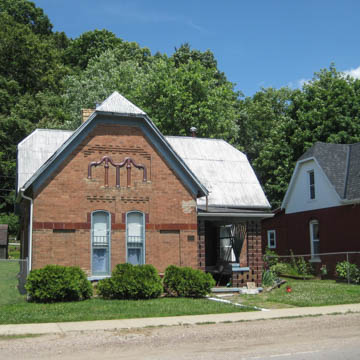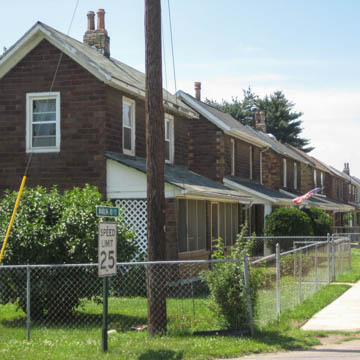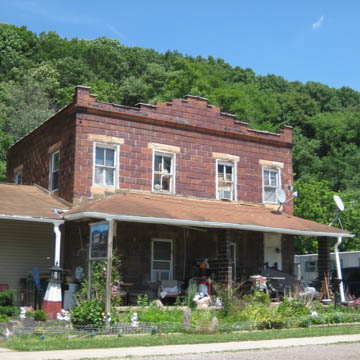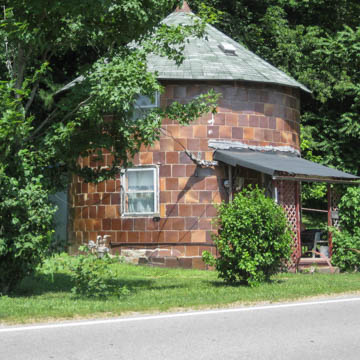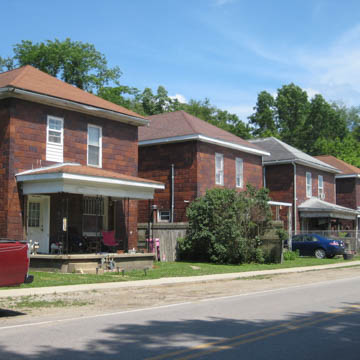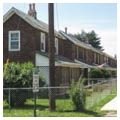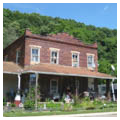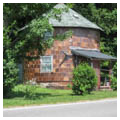A notable example of a company town in Ohio is Haydenville, located about sixty miles southeast of Columbus in the Hocking Hills of Hocking County. Haydenville was distinctive in that nearly all the buildings in the village were constructed of products made by the Haydenville Mining and Manufacturing Company. As a result, the town served as a living advertisement for the company. Extractive industries such as coal, clay, and iron played a major role in the economic development of the natural resource-rich Hocking Valley in southeastern Ohio. While most of this area’s extractive industries ceased operation decades ago, in many places the company town (or its remnants) survives as an important element of an industrial cultural landscape. In order keep workers close to their places of employ, manufacturers in rural areas often erected buildings intended primarily for the use of their employees. A typical company town included houses that could be rented inexpensively by employees, a store owned by the company, and often a school, church, and social hall. As settlements, company towns were characteristically built in a linear, compact area with the houses in close proximity to each other.
In the mid-nineteenth century, Columbus industrialist Peter Hayden (1806–1888), recognized the importance of Hocking County’s rich natural resources, especially coal and clay, and began buying up land. Transportation into the region improved with the opening of the Hocking Canal in the mid-nineteenth century, and by the 1870s the Columbus, Hocking Valley and Toledo Railway, with Hayden as a major investor and a corporate officer, reached the land he owned. In 1882 Hayden formed (and became president of) the Haydenville Mining and Manufacturing Company. The company soon developed the village of Haydenville around the clay factory.
The factory produced clay building blocks, chimney tops, ceiling tiles, floor arches, partitions, sewer tile, stove pipe, and fire brick. In later years, sidewalk bricks and street paving block with a distinctive circle design were manufactured there as well. The earliest houses were two stories, with one-story side wings, slate roofs, and two rows of brick corbelling above the arched front windows. These houses faced the factory and the main street running through the town. Additional houses were tall, narrow, two-storied, saltbox-style houses built of kiln-dried bricks, some with decorative corner quoins and most with chimney pots also made in the factory. One of the most distinctive house types was the one-story, three-gable, jerkinhead-roofed houses built of brick and tile, often with other company-manufactured products added for decoration. These houses had narrow, paired windows on the facade, a small porch, and central chimneys with factory-made chimney pots. Facade decorations featured a wide array of factory-made products including, most imaginatively, sewer pipes. Haydenville’s two cemeteries contain some hand-fashioned clay headstones and large chimney pots inscribed with the dates of the deceased.
A new Methodist church built of factory-made, rock-faced brick, paving blocks, and various tiles replaced an earlier wood frame church. Peter Hayden donated the large stained glass window and his daughter donated the bell. Hayden died before the 1892 completion of the church, and his son Charles became president of the company. In 1902 the town, factory, and mines were sold to the National Fire Proofing Company of Pittsburgh for $75,000. By 1907 the name was changed to National Automatic Tool Company (NATCO), which was expanding nationally. Between 1907 and 1914 more houses were built, including some two-story tile duplexes, box-like structures, built to house new Eastern European workers coming to work in the factory on the eve of World War I.
Another distinctive house type was built during this time: the round house. Built of curved silo tiles, it had four rooms, two on each floor. Several round houses were built, but only one remains. Other single-family dwellings built during the early twentieth century included two-story, hip-roofed houses with a kitchen or mud room at the rear. The houses continued to be built in a linear development pattern.
The company closed Plant No. 1 in 1958; Plant No. 2 followed in 1962. In 1964 NATCO sold the town of Haydenville to an attorney and realtor from Washington, Pennsylvania, for $100,000. The factories and kilns were demolished soon after the purchase. More than a hundred houses were offered for purchase to their current occupants, people who, until then, had been tenants of NATCO. Half were sold to the residents and the balance at public sale.
Significant portions of Haydenville’s historic masonry resources remain as a reminder of the era when companies owned entire towns—from the worker’s houses, to stores, churches, schools, and recreation areas.
References
Koe-Krompecher, Laszlo G., “Haydenville Historic Town,” Hocking County, Ohio. National Register of Historic Places Inventory-Nomination Form, 1973. National Park Service, U.S. Department of the Interior, Washington, DC.
Lake, D. J., CE. Atlas of Hocking County, Ohio.1876. Reprint, Athens, OH: Hocking County Historical Society, Union Printing Company, 1975.
Mould, David. “The Company Town that outlived the Company: Haydenville, Ohio.” Journal of Cultural Geography5, no. 2 (March, 1985): 71-86.










